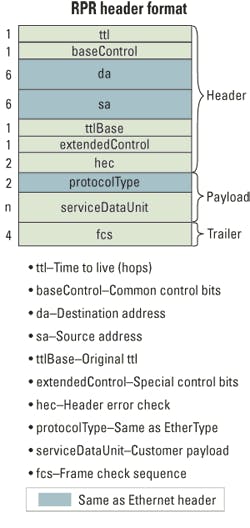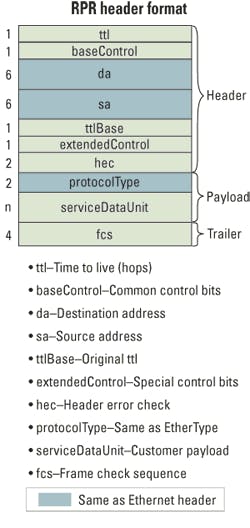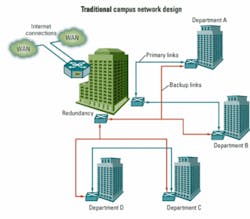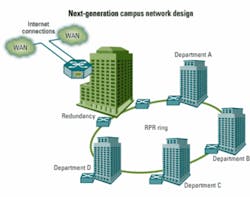RPR simplifies campus communications
by Vinay Bannai
Campus networks by nature are usually widely distributed. In a typical campus environment, the connectivity between various data centers can range anywhere from tens to hundreds of sites. Most campuses firewall or protect each of the departments individually but usually share a backbone transport network that interconnects all sites to provide uniform network connectivity.
Large enterprise networks mimic some aspects of campus networks. However, enterprise networks are usually more controlled in terms of allowing connectivity and access to unqualified and unauthorized software. From a topology perspective, a medium to large enterprise would have multiple buildings and departments interconnected by a backbone transport network with each department connected to the core transport network by a router, firewall, virtual private network (VPN), or all of the above.
Significant resources and effort are spent to maintain the backbone network to provide resiliency, proper quality of service (QoS), and equal best-effort traffic utilization to departments and groups on campus. Resilient Packet Ring (RPR, otherwise known as IEEE 802.17) can help network managers meet these requirements. RPR provides survivable dual counter-rotating optical rings with several advantages over traditional enterprise network architectures, including support of oversubscription and variable bandwidth per span as well as the provision of advanced traffic routing capabilities.
RPR is among the standards the IEEE has defined to enable carrier-class Ethernet. This work has included provider bridging standards (802.1ad and 802.1ah), fault management (802.1ag), and link operation, administration, and maintenance (OAM) (802.3ah) as well as the RPR specifications defined in 802.17. RPR was standardized by the IEEE 802.17 Working Group in 2004. The primary focus of IEEE 802.17 has been to standardize the media access control (MAC) layer technology for enabling carrier-class RPR over SONET/SDH or Ethernet physical layer transceivers (PHYs). Currently, the IEEE 802.17 Working Group is in the process of standardizing 802.17b, which enhances the RPR bridging methodology for Ethernet packets sourced and/or destined to stations off the ring.RPR allows both campuses and enterprises to streamline their backbone networks while offering a seamless migration of their transport networks to a more efficient, distributed, and resilient packet-switched architecture. This protocol is ideally suited for next-generation campuses and enterprise networks with a converged network layer for carrying voice, video, and data.
RPR, as defined by IEEE 802.17, provides an optimized ring network that offers resiliency, service differentiation with guaranteed class-of-service performance, highly efficient utilization of all available bandwidth, fair access to available bandwidth, and plug-and-play simplicity. RPR interfaces and frames look very much like those of Ethernet, but with some extensions. RPR combines the simplicity of Ethernet with the service-level performance of SONET/SDH.
RPR provides resiliency through dual unidirectional fiber rings (with each fiber forming one “ringlet” of the ring). Any break in physical or logical connectivity is detected and routed away from the ring in less than 50 msec for rings up to a few thousand kilometers in circumference. Additionally, the ring is monitored for topology changes, changes in the characteristics of each RPR switch, and consistent views across all switches in a ring. This wealth of information enables much easier and much greater understanding of an RPR network than is available for a simple collection of independent switches.
In addition to the OAM features built into RPR, all of the Layer 2 (L2) OAM initiatives defined in IEEE 802.1 and by the ITU-T can be performed over RPR networks the same as over Ethernet networks. This allows rings to be one component of a much larger and very diverse network. RPR provides the ability to offer service-level guarantees in terms of bandwidth, delay, and jitter. This is accomplished without the fixed circuits of traditional TDM networks and the statistical-only assurance of traditional packet networks. A queuing algorithm is implemented that uses ring feedback to provide immediate access to the ring for highly delay-sensitive services, timely access for moderately delay-sensitive services, and full utilization for best-effort services. Because of this queuing algorithm, all unused bandwidth can be used by opportunistic traffic without affecting the delay-sensitive traffic.
Not only does RPR take advantage of all available bandwidth, it also avoids the shortcoming of other rings by removing traffic as quickly as possible. This allows the remainder of the ring to be used for other traffic. (The capability is referred to as “spatial reuse.”) All opportunistic or best-effort traffic gets fair access to the ring bandwidth with no advantage or disadvantage to relative position on the ring. Traditional packet networks often give advantage to the earliest or last to enter a network (depending upon the network type), with traffic trying to enter at the opposite end at a great disadvantage. The same queuing algorithm using ring feedback that helps maintain service class also provides the fair access for best-effort traffic. Where equality is not desired, weighted fairness can be employed.
RPR rings can get as large as 2,000 km in circumference with up to 255 nodes on the ring at the same time. The network acts as a distributed L2 virtual LAN (VLAN) switch.
RPR provides QoS by class-of-service code points:
• Class A is primarily used for low-latency, low-jitter guaranteed delivery traffic. Typically, it’s used for stratum-quality voice, voice over IP, and broadcast-quality video.
• Class B is primarily used for guaranteed-delivery traffic, such as data services requiring service-level agreement assurances.
• Class C is used for all other traffic. Class C is the equivalent of best-effort traffic with the exception that all nodes in the ring get a fair share of the available traffic on the ring (any bandwidth left over after Class A and Class B traffic needs have been satisfied is considered available bandwidth).Similar to Ethernet switches, and quite unlike SONET/SDH add/drop multiplexers, RPR switches can be plugged into and removed from a ring dynamically. No advance provisioning is needed and nothing more than a few milliseconds of outage results.
RPR and Ethernet share a lot in common. RPR’s logical MAC interface, in its default usage, is exactly the same as Ethernet’s. RPR’s frames look very similar to Ethernet frames, with slightly more fields added. Figure 1 shows the RPR frame structure and its similarity to the Ethernet frame structure. RPR even uses 1- and 10-Gbit/sec PHYs defined for use by Ethernet (in addition to also being able to use SONET/SDH PHYs). Any service that runs on top of Ethernet also runs on top of RPR. Every service that Ethernet provides is also provided by RPR. Ethernet and RPR work together seamlessly in bridged/switched networks.
The challenge associated with constructing an optical backbone network that connects multiple campus networks is ideally suited for an RPR application.
A typical design for a campus network is shown in Figure 2. In this configuration, the various buildings and departments are connected together in a hub-and-spoke fashion with the aggregation taking place in a central network operations center (NOC) on the campus where the Internet services and voice services are rendered. This has been the traditional approach and has several limitations:
- Nonredundant interconnections between the central NOC and the buildings.
- Difficult to expand to newer buildings.
- Upgrade to higher speeds requires network-wide outage.
The standard mechanism of providing redundant connections at the campus aggregation center (NOC) is achieved by installing two routers, but this also requires more than one link to the various buildings and departments as shown in Figure 2. This makes the connectivity complex and increases the expense related to operation and equipment.
As the campus adds newer buildings and reconfigures connections, it becomes a little difficult to manage and interconnect all the buildings and increases the port density at the campus aggregation router. Upgrading the campus backbone network to a higher speed requires an overhaul of all the network interfaces at each of the buildings.
An alternate way to design campus networks is to employ RPR rings for the backbone transport as shown in Figure 3. In this configuration, the various buildings and departments on the campus are interconnected in an RPR ring. The network devices resident in the departmental buildings are L2 VLAN switches with RPR interfaces connected to the ring. RPR can bridge traffic from 802.3 Ethernet LAN to RPR rings at L2 without needing Layer 3 devices or routers. The bridging is governed by the rules specified in the 802.1 bridging standard and is applicable to all MACs defined by the 802 Local Area Network and Metropolitan Area Network (LAN/MAN) group.
This results in an intelligent network with built-in resiliency for a low cost and reduced number of ports and interfaces at the campus aggregation center. The RPR devices deployed in this configuration have typical L2 features like access control lists, port mirroring, access and trunk-based VLANs, port rate limiting, and shaping. Given the inherent ability to support multiple PHYs in an RPR network, most RPR devices are likely to have small-form-factor pluggable (SFP) optics. This design also helps in centralizing the router with WAN assets in the campus aggregation center.
In conclusion, using RPR rings to interconnect various locations on a campus or in an enterprise environment provides a superior value to the customer and brings Carrier Ethernet qualities to the backbone transport network. RPR is closely aligned with Ethernet and completely interoperable with other 802 MACs. It is also a product of the same standards body responsible for standardizing Ethernet technology. With built-in OAM capabilities, 50-msec resiliency, and the optical interfaces of RPR equipment, campus and enterprise networks can now leverage carrier-class Ethernet features typically available on core and metro devices.Vinay Bannai is product line manager and manager of systems strategy and planning for Carrier Ethernet at ADTRAN (www.adtran.com). He has been actively involved in the standardization of RPR in IEEE and holds a master’s degree in computer science from Stanford University.



